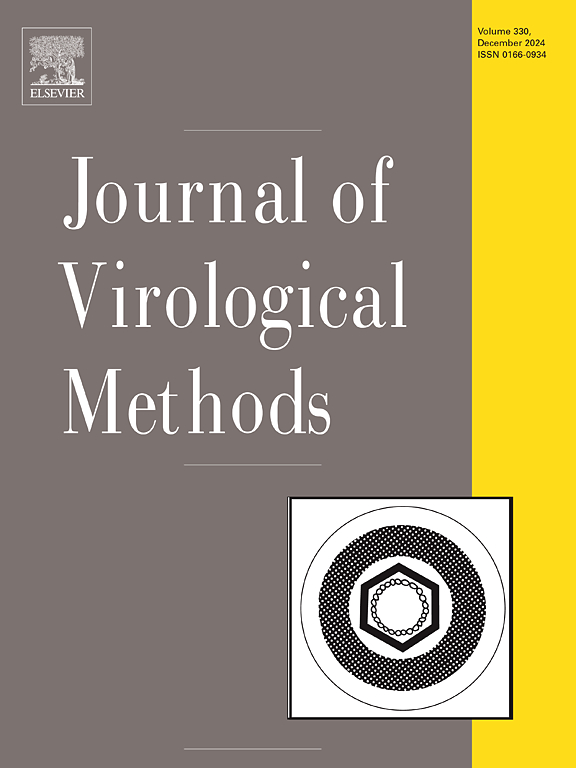Development and validation of an all-in-one rabies virus Bat-Clade genomic sequencing and host identification protocol
IF 2.2
4区 医学
Q3 BIOCHEMICAL RESEARCH METHODS
引用次数: 0
Abstract
Rabies virus (RABV), remains a significant public health concern, with bat-maintained lineages accounting for all currently documented cases in Brazil. Despite the availability of pharmacological prophylaxis for humans and animals, the high genetic diversity of RABV in diverse natural bat hosts and continued circulation in multiple animals pose challenges for effective surveillance. Here, we developed and validated a novel, rapidly deployable amplicon-based sequencing approach for RABV genomic surveillance. This "all-in-one" protocol integrates whole RABV genome sequencing with host species identification through COI gene amplification and sequencing, addressing the challenges posed by RABV's high genetic diversity and complex transmission dynamics. We assessed the protocol's effectiveness by sequencing 25 near-complete RABV genomes from host species across four distinct families (Bovidae, Equidae, Felidae, and Microchiroptera) obtained from the Rabies Control and Surveillance Program from the Rio Grande do Sul State, Southern Brazil. The method achieved an average genome coverage of 91.4 % at a minimum 5x read depth, with a mean depth coverage of 816x across sequenced genomes. The results demonstrated significant Bat-Clade sublineage diversity, which was classified using the MADDOG RABV lineage system. The protocol successfully identified three bat species (Tadarida brasiliensis, Desmodus rotundus, and Myotis nigricans) among the samples, highlighting its capability for precise host identification. This study presents a powerful tool for high-resolution evaluation of RABV genomic features and host identification, enabling more targeted animal and human health interventions. This new approach has the potential to enhance RABV surveillance capabilities, contributing to more effective rabies control strategies within a One Health framework.
狂犬病病毒蝙蝠进化支基因组测序和宿主鉴定方案的开发和验证。
狂犬病毒(RABV)仍然是一个重大的公共卫生问题,巴西目前记录的所有病例都是由蝙蝠维持的谱系造成的。尽管人类和动物可获得药物预防,但RABV在不同天然蝙蝠宿主中的高度遗传多样性以及在多种动物中的持续传播给有效监测带来了挑战。在这里,我们开发并验证了一种新的、可快速部署的基于扩增子的RABV基因组监测测序方法。这种“一体化”方案将RABV全基因组测序与宿主物种鉴定结合起来,通过COI基因扩增和测序,解决了RABV高遗传多样性和复杂传播动态带来的挑战。我们通过对来自巴西南部南巴西大德州狂犬病控制和监测项目的宿主物种(牛科、马科、Felidae和小翼目)的25个接近完整的RABV基因组进行测序,评估了该方案的有效性。该方法在至少5倍的读取深度下实现了平均91.4%的基因组覆盖率,测序基因组的平均深度覆盖率为816倍。结果显示了显著的蝙蝠分支亚系多样性,使用MADDOG RABV谱系系统进行分类。该方案成功鉴定了样本中的3种蝙蝠(Tadarida brasiliensis、Desmodus rotundus和Myotis nigricans),突出了其精确鉴定宿主的能力。这项研究为RABV基因组特征的高分辨率评估和宿主鉴定提供了一个强大的工具,使更有针对性的动物和人类健康干预成为可能。这种新方法有可能加强狂犬病病毒监测能力,有助于在“同一个健康”框架内制定更有效的狂犬病控制战略。
本文章由计算机程序翻译,如有差异,请以英文原文为准。
求助全文
约1分钟内获得全文
求助全文
来源期刊
CiteScore
5.80
自引率
0.00%
发文量
209
审稿时长
41 days
期刊介绍:
The Journal of Virological Methods focuses on original, high quality research papers that describe novel and comprehensively tested methods which enhance human, animal, plant, bacterial or environmental virology and prions research and discovery.
The methods may include, but not limited to, the study of:
Viral components and morphology-
Virus isolation, propagation and development of viral vectors-
Viral pathogenesis, oncogenesis, vaccines and antivirals-
Virus replication, host-pathogen interactions and responses-
Virus transmission, prevention, control and treatment-
Viral metagenomics and virome-
Virus ecology, adaption and evolution-
Applied virology such as nanotechnology-
Viral diagnosis with novelty and comprehensive evaluation.
We seek articles, systematic reviews, meta-analyses and laboratory protocols that include comprehensive technical details with statistical confirmations that provide validations against current best practice, international standards or quality assurance programs and which advance knowledge in virology leading to improved medical, veterinary or agricultural practices and management.

 求助内容:
求助内容: 应助结果提醒方式:
应助结果提醒方式:


